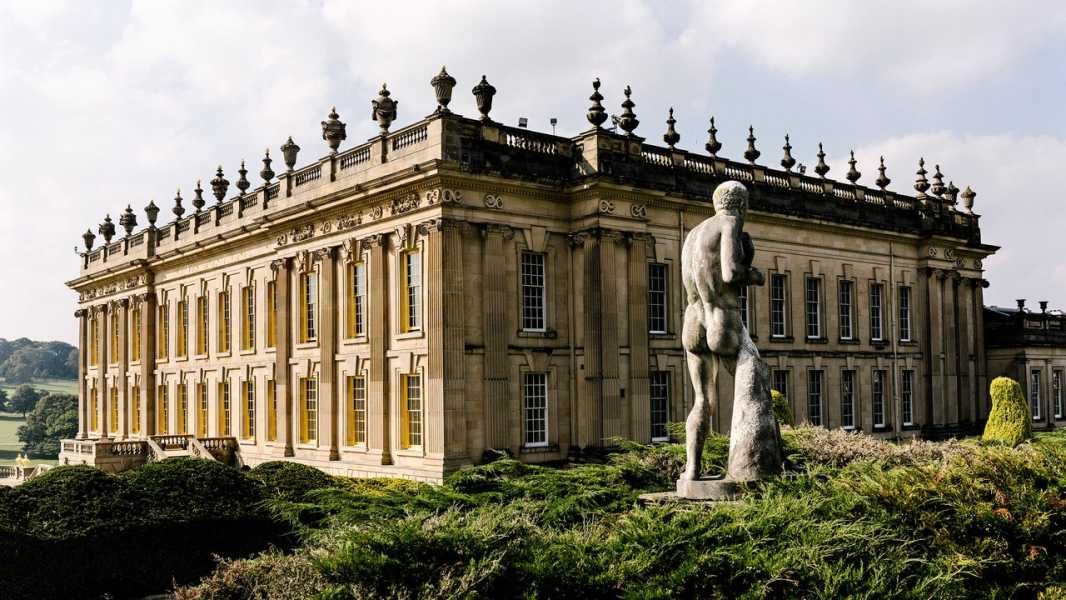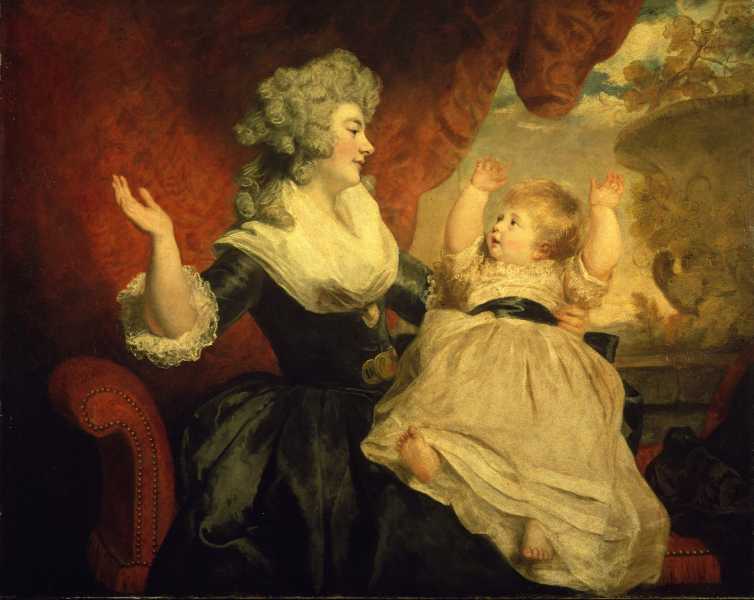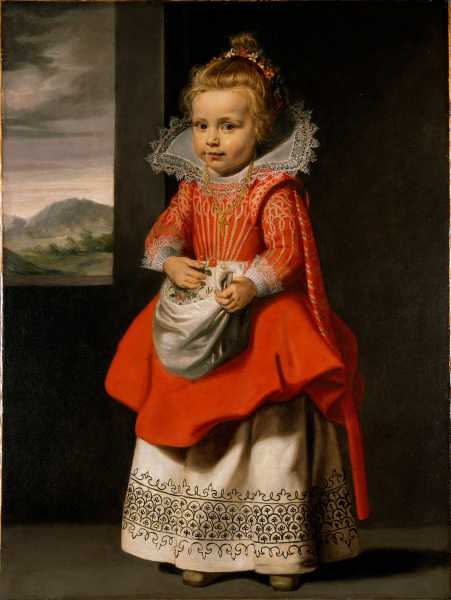
Save this storySave this storySave this storySave this story
Architecture buffs might visit Chatsworth House for the important role it played in the development of the English Baroque; garden enthusiasts might relish its rose garden and dell of azaleas. Lovers of English literature, or its cinematic adaptations, might choose an outing to Chatsworth on the strength of its having been the picturesque stand-in for Pemberley, the covetable country seat of Mr. Darcy, in the 2005 film version of Jane Austen’s “Pride and Prejudice.” But, for many others, the draw of the place long included the tantalizing possibility that one might be admiring, say, a Michael Leonard portrait of the current Duchess, the former Amanda Heywood-Lonsdale, only to have the real thing pass by on a shortcut from one zone to another of the family’s private quarters, which are distributed all over the building rather than being consolidated in one wing or corner.
This wasn’t always the case. In 1950, at the age of thirty, Andrew Cavendish precipitously inherited a centuries-old title—the dukedom of Devonshire—becoming the eleventh holder of vast swaths of agricultural land, acres of grouse moor, a valuable collection of art and antiquities, and the then private Chatsworth House, the family seat in Derbyshire, in the East Midlands. He also inherited a problem: despite the best efforts of his father to minimize his heir’s forthcoming tax burden, the new young Duke, who had come by the title only because his older brother had been killed in the Second World War, was on the hook for death duties amounting to eighty per cent of the value of the estate.
Lesser peers might have sold up and slunk off to a comfortably appointed town house in Belgravia. But the eleventh Duke decided to try to strike a balance between satisfying his debt to the state and hanging on to what he could of the family’s heritage. Significant assets were disposed of—paintings by Rembrandt and Holbein; a secondary stately home, Hardwick Hall, which went to the National Trust; big chunks of Scotland—and Chatsworth itself was repurposed into a combination tourist destination and family home. Largely under the formidable direction of the Duchess of Devonshire, the former Deborah Mitford, the house, which had not been consistently inhabited by the Cavendish family for decades, was extensively renovated. After Chatsworth opened in its new incarnation, the readying of the estate for the visiting public each March was of a different order relative to that of most people’s spring-cleaning: “The house opens tomorrow & they have just finished putting a steel rod to support the main landing on top of the stairs where crowds congregate & it might have collapsed, imagine how awful if that had happened,” Debo, as the Duchess was known to her family, wrote to her sister Pamela on April Fools’ Day, 1969.
Under the energetic promotion of the eleventh Duke and the Duchess, Chatsworth was presented to the public as a family home—albeit one that stretched most people’s definition of the term, given the scale of the private quarters, which included multiple drawing rooms, sitting rooms, studies, bedrooms, and a dining room the same size as the State Dining Room, directly overhead and open to the public. Debo wrote a guidebook to Chatsworth, which not only described its lavish, public reception rooms but also gave thumbnail sketches of private areas, such as Andrew Cavendish’s bedroom, which had dark-green wallpaper, yellow curtains, and a chest of drawers stuffed with regimental neckties. “As he is color-blind he has to be inspected before going out,” she wrote, with unexpected intimacy.
These days, the house is no longer owned by the Cavendish family itself but by the Chatsworth Trust, a not-for-profit entity. But the proximity of the noble family remains part of the house’s attraction, and, in recent years, day-trippers have been alert to the possibility that they might cross paths with the current Duke, the twelfth, Peregrine Cavendish, known familiarly as Stoker, who, along with his wife, took over the occupancy after the death of Andrew, his father, in 2004. (Debo became the Dowager Duchess and moved to a smaller property on the estate. She died in 2014.) A visit to Chatsworth offers the fascination of mapping one dimension of the house—the publicly visible one, with its Painted Hall, which was commissioned by the first Duke and whose walls and ceiling display ornate scenes from the life of Caesar—onto another, invisible realm of contemporary privilege that lies just beyond this imposing door or that concealed passageway. For the continuing right to live in the house that belonged to the family for seventeen generations, the Duke and Duchess pay rent to the Trust; in 2020, the last year for which a base figure is publicly available, the total was a very reasonable sixty-five hundred pounds a month, utilities included. One longs to know how the Trust came up with the comps.

Portrait of Lady Georgiana Cavendish, the Duchess of Devonshire, with her daughter Lady Georgiana Cavendish.
Art work by Joshua Reynolds, Courtesy Chatsworth House Trust
Chatsworth’s enduring status as a family home is brought into relief by an exhibition currently being held in the house and its garden, “Picturing Childhood,” which draws on the Devonshire Collections, as well as a handful of loans, to illuminate aspects of the lives of children who either lived in the house or were otherwise associated with it. One highlight: a portrait, from 1784, by Sir Joshua Reynolds, of Lady Georgiana Cavendish, the Duchess of Devonshire, who was married to the fifth Duke, in 1744, on her seventeenth birthday. She is portrayed with her two-year-old daughter, Lady Georgiana Cavendish, known in the family as Little G, who is seated on her mother’s lap, gleefully throwing both her arms into the air and kicking her bare feet from under her long white gown. The Duchess raises her own right hand in what is either a mirroring action or an invitation for the child to play copycat—an illustration of what was at the time a new understanding of the distinctiveness of childhood as a phase of life, influenced by the theories of Jean-Jacques Rousseau.
“Picturing Childhood” incorporates elements clearly designed to engage the interest of younger guests, who, like Little G, might have little tolerance for the formality that a grand house sometimes appears to require. There are hopscotch grids painted onto the pathway by which visitors approach the house, and interactive exhibits throughout the property. In the State Dining Room, a work by the artist Tasha Marks, “Aromas of Dinners Past,” offers the chance to lift up large silver lids and sniff platters from which emanate the smell of asparagus or port, among other comestibles. The enormous table is set with silver candelabras and ruby-colored stemware, as it must have been when, at age thirteen, an especially honored guest—the future Queen Victoria—sat down for her very first formal dinner rather than consume her meal upstairs in the nursery quarters, as she had previously done. Elsewhere, there are portraits of aristocratic children from eras earlier than Victoria’s. These include an exquisite painting by Cornelis de Vos of his daughter and an arresting image of the two-year-old Lady Arbella Stuart, born in 1575, at Chatsworth. Dressed in an ornate dress and headwear, the serious-faced girl holds in her hand a doll that strongly resembles the childless Queen Elizabeth I, to whom Arbella was once thought a potential successor. Where the portrait of Lady Georgiana and Little G illustrates—despite their finery—the universality of an outburst of childish joy, the portrait of Lady Arbella suggests the weighty expectations placed on—and the freighted identities of—those born to such rarefied privilege.

Portrait of Magdalena de Vos, the artist’s daughter, in the exhibition “Picturing Childhood.”
Art work by Cornelis de Vos, Courtesy Chatsworth House Trust
The fact that aristocratic families both resemble ordinary, non-titled families and are startlingly different from them is self-evident. At Chatsworth, in the “resemble” column, you have the reality that the residents of the estate, as of any other home, need sufficient closets and adequate bathrooms. (Debo added seventeen of the latter.) The “differ wildly” column includes the reality that the maintenance of most family homes does not generally require fifteen hundred sheets of gold leaf, which were reportedly used to regild almost four hundred window frames, as part of a thirty-three-million-pound renovation undertaken during the past decade by the current Duke and Duchess. Having completed the so-called master plan, the Duke and Duchess have decided to move to a smaller property on the estate, thereby freeing up the private quarters of Chatsworth House for their heir and his wife, now Lord and Lady Burlington, and their three children.
The Burlingtons, of course, will have their own inclinations about how to conduct family life amid the splendors accreted by their forebears. Earlier this year, the Daily Mail reported that the family had submitted plans to Historic England, the public body concerned with heritage issues, for the installation of a new eat-in kitchen and a family room in the so-called Stag Parlour, in the private quarters on the ground floor. This room was used in Debo’s era as “the breakfast-room, and morning place of refuge for the idle”; according to the plans, the hoped-for renovation includes that defining accoutrement of a middle-class modus vivendi—a kitchen island. “Family life in a great house is now very different from how it was in the past,” the application reads. “No longer are children confined to nurseries, but a family room which allows parents to cook for, and eat with, their children and friends is an essential ingredient for a vibrant home.” In a neat reversal of the time-honored division of upstairs and downstairs, it is now the public who tread the polished floors of the state rooms, admiring centuries-old paintings and sniffing porcelain salvers infused with the scent of Victorian recipes. Downstairs, meanwhile, the aristocrats gather around their plain kitchen table, in the mode of a modern family but with the instincts of an ancient one: holding on to their privilege by strategically surrendering it. ♦
Sourse: newyorker.com






